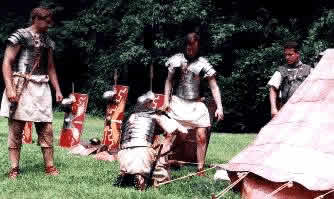Armor
Armor is one of the most important part of any soldier's equipment. This holds true today, and was true for the soldiers of Rome. The technology of armor has changed, but the principle remains the same: protect the wearer during battle. While modern armor is mainly centered around protecting against bullets, the armor of Rome was designed to protect mainly against projectiles such as spears or javelins, arrows, swords, or daggers.
Roman Army - 160 BCE
The armor of the Roman army around 160 BC was mainly comprised of a shield, the scutum, and body armor that varied depending on rank and position, consisting of a breastplate and one greave, on the left leg. The scutum was a curved oval shield made from two sheets of wood glued together and covered with canvas and leather, usually with a spindle shaped boss along the vertical length of the shield. It can be considered a body shield, and was extremely heavy (~10kg). When a legionary charged with the shield, he would hold it with a straight arm and rest it on his left shoulder, then run towards the enemy with full force in an attempt to knock his foe over. He would then kneel behind the shield and fight from behind it. An example of this type of shield was found at Kasr El Harit in the Fayum in Egypt. It is 1.28m long and 63.5cm wide, and is constructed of laminated birch. Nine or ten strips of birch from 6-10cm wide were glued in-between two layers of thinner strips laid out perpendicular to the middle layer. The shield is thickest in the center (1.2cm), and is slightly less than a centimeter thick at the edges. The shield was covered with felt which was stitched through the wood. The grip was horizontal, and was meant to be held from the top. This type of shield probably also commonly featured an iron edging on the top and bottom rims. The shields of the legionary had to be of regulation size, and a soldier could be severely reprimanded if his shield was too large.
Body armor of the principes (heavy infantry), hastati (front-line soldiers), and triarii (veterans) consisted of only a 20cm square breastplate, called a heart guard (pectorale), and one greave. The one greave was worn on the left leg, the leg that was exposed during battle. The pectorale was either square or round. Wealthier soldiers wore mail shirts that were very heavy, weighing about 15kg. This weight was quite a problem in the account of the battle of Lake Trasimene, where soldiers that tried to swim away were drowned by their armor. The principes and hastati also wore a bronze helmet with a ring of three black or purple feathers about 45cm high. This was to make each man look twice his height.
The velites (lightly armed soldiers) wore no armor at all, except a plain helmet. Sometimes decorated with wolf skin or some other unique mark so that the centurions could recognize them from a distance and judge their skill in battle.
Cavalry was equipped in the Greek fashion, with a cuirass and round shield (parma equestris). They also wore a mail shirt identical to that of the legionaries, aside from a split in the middle that allowed them to sit on a horse.
Roman Army - 100 BCE to 200 CE
By the first century CE the method of recruitment had changed: recruitment was now open to all citizens, regardless of wealth. Previously the system was based on wealth, and the light-armed velites were drawn from the poorest class, because all soldiers were financially responsible for their own armor. With the new open recruitment, the government had to provide cheap, mass-produced armor, for which the deductions were made in the soldier's pay. The quality of this work is evident in helmets from the period, which are very poorly made, utilizing every shortcut possible.
Helmets were of several types. The older Montefortino helmet was bowl shaped, with a topknot that was filled with lead, and a hole for insertion of a feather. The Coolus type helmet was a round bronze helmet with a small neck guard, and the Port type, which was an iron helmet with a long neck guard. The Port type had a topknot that was adapted to hold the crest, and the helmet later became what is known as the imperial Gallic type. The Gallic type enlarged the neck guard further, and included metal cheek-guards, which protected the face. It also featured a reinforced rib along the forehead to protect against downward slashes. After the Coolus type disappeared in the middle of the first century, and from then on all helmets were made of bronze.
Senior officers dressed in the Greek style, with a muscled cuirass, helmet and greaves. Under the cuirass he wore a tunic made of leather with strips of leather or fabric hanging from the waist and shoulders. The officer wore a sash around his waist which is knotted in the front, with the loose ends tucked up at either side. This was the Greek symbol of high rank.
The standard armor of the first century was the lorica segmentata, which was a segmented armor. It was constructed of strips of iron joined together with hooks or straps. It covered the chest and shoulders, affording good protection from spears, missiles, and swords. It has decorative hinges which served no purpose. The lorica segmentata weighed about 9kg.
The scutum underwent an evolution, first with the top and bottom getting squared off, then becoming a completely rectangular, curved shield. The faces of the shields were often decorated with patterns that identified a particular unit.
The armor of the Roman Army was one of the many factors that made it the best fighting force in the world.

